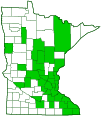shaggy soldier
(Galinsoga quadriradiata)
Conservation • Weed • Wetland • Description • Habitat • Ecology • Use • Distribution • Taxonomy
Description |
||
Shaggy soldier is a small summer annual. It is native to central Mexico and possibly also to Central and South America. It has been introduced worldwide. In the United States it is now naturalized in the northeast, southeast, and north-central regions, and is adventive in the remainder of the country. It is found mostly in disturbed areas, including roadsides, fields, vacant lots, orchards, gardens, greenhouses, and neglected lawns. It grows under full or partial sun in moist or moderately moist, loamy soil. Shaggy soldier is a 3″ to 24″ (8 to 62 cm) tall, erect, annual forb that rises on a branching stem from a small taproot and fibrous roots. The stem is erect or ascending, leafy, and finely ridged and grooved. It has few to many branches and is moderately to densely covered with spreading hairs. Hairs near the top of the stem have minute dark glands at the tip. The leaves are opposite, ¾″ to 2⅜″ (20 to 60 mm) long, and ⅝″ to 1¾″ (15 to 45 mm) wide. They are on slender, up to 1½″ (4 cm) long leaf stalks (petioles). The leaf blades are lance-shaped to egg-shaped and unlobed. They are mostly angled or short-tapered at the base and are angled or tapered to a sharp point at the tip. The upper and lower surfaces are sparsely to densely covered with short, slender, more or less spreading hairs. Three main veins are visible on the upper side. The margins are sparsely to moderately toothed with distinct, narrowly angled teeth, and they have a fringe of short, slender, more or less spreading hairs. The inflorescence is an irregularly branched cluster (panicle) or loose cluster of flower heads, or sometimes just a single flower head, at the end of the stem and branches, and rising from the upper leaf axils of the main stem. Each flower head is on a 3⁄16″ to ¾″ (5 to 20 mm) long stalk (peduncle). The peduncle is covered with gland-tipped hairs. Each flower head is small, just ¼″ to ½″ (6 to 12 mm) in diameter. At the base of each head there is a ⅛″ to 3⁄16″ (3 to 5 mm) long, ⅛″ to ¼″ (3 to 6 mm) in diameter, hemispherical to bell-shaped, cup-like whorl (involucre) of 8 to 12 bracts (phyllaries) in two series. All of the phyllaries are green and are moderately to densely covered with gland-tipped hairs. The inner series of 4 to 6 bracts are longer and broader than the outer 2 or 3 bracts. Each phyllary is fused to two thin dry (chaffy) bracts on the upper part of the peduncle (receptacle). The phyllaries and their chaffy bracts are dropped as an intact unit with the fruits developing from the ray florets. The flower head has usually 5 widely spaced ray florets, sometimes just 4 or up to 8, and 15 to 35 disk florets. Both ray florets and disk florets are fertile. Each ray floret is usually white, with a tube-like portion at the base and a 1⁄16″to ⅛″ (2 to 3 mm) long, widely spreading portion (lamina). The lamina has three teeth at the tip. There is a well developed tuft of bristles (pappus) at the base that is as long as the corolla tube. Sometimes the rays are pink, and flower heads with both ray colors can appear on the same plant. The disk flowers are yellow. The corollas are 1⁄32″ to 1 ⁄16″ (0.8 to 1.5 mm) long and have 5 minute lobes. The fruit is a black, 1⁄16″to ⅛″ (1.5 to 2.5 mm) long, inversely cone-shaped or inversely pyramid-shaped (with the narrow end at the base), dry capsule (cypsela). At the base of each cypsela there is a yellowish pappus, usually shorter than the cypsela, that spreads outward as the cypsela matures. The seeds germinate quickly, and there are usually two or three generations each year. This is the feature that gives the plant one of its other common names, quickweed. |
||
Height |
||
3″ to 24″ (8 to 62 cm) |
||
Flower Color |
||
White ray florets, yellow disk florets |
||
Similar Species |
||
Gallant soldier (Galinsoga parviflora var. parviflora) stem hairs are mostly appressed, not spreading, and not glandular. The leaf margins have obscure, rounded teeth. The inner phyllaries are persistent, they do not fall off. The ray florets have no pappus or just a minute pappus that is not visible without a hand lens. It is less common but just as widespread in Minnesota. |
||
Habitat |
||
Moist to moderately moist. Disturbed areas including roadsides, fields, vacant lots, orchards, gardens, greenhouses, and neglected lawns. Full or partial sun. Loamy soil. |
||
Ecology |
||
Flowering |
||
June to October |
||
Pests and Diseases |
||
|
||
Use |
||
|
||
Distribution |
||||
|
Sources |
|||
| 9/13/2022 | ||||
Nativity |
||||
Native to central Mexico. Introduced and naturalized in Minnesota. |
||||
Occurrence |
||||
Common |
||||
Taxonomy |
|||
| Kingdom | Plantae (green algae and land plants) | ||
| Subkingdom | Viridiplantae (green plants) | ||
| Infrakingdom | Streptophyta (land plants and green algae) | ||
| Superdivision | Embryophyta (land plants) | ||
| Division | Tracheophyta (vascular plants) | ||
| Subdivision | Spermatophytina (seed plants) | ||
| Class | Magnoliopsida (flowering plants) | ||
| Superorder | Asteranae | ||
Order |
Asterales (sunflowers, bellflowers, fanflowers, and allies) | ||
Family |
Asteraceae (sunflowers, daisies, asters, and allies) | ||
| Subfamily | Asteroideae | ||
Tribe |
Millerieae | ||
| Subtribe | Galinsoginae | ||
Genus |
Galinsoga (galinsogas) | ||
Subordinate Taxa |
|||
|
|||
Synonyms |
|||
Adventina ciliata Galinsoga aristulata Galinsoga bicolorata Galinsoga caracasana Galinsoga ciliata Vargasia caracassana |
|||
Common Names |
|||
ciliate galinsoga common quick-weed, fringed quickweed hairy galinsoga Peruvian daisy Peruvian-daisy quickweed quick-weed shaggy galinsoga shaggy soldier shaggy-soldier |
|||
Glossary
Axil
The upper angle where a branch, stem, leaf stalk, or vein diverges.
Bract
Modified leaf at the base of a flower stalk, flower cluster, or inflorescence.
Chaff
Thin, dry scales or bracts; the bracts on the receptacle of the flower head of some Asteraceae.
Corolla
A collective name for all of the petals of a flower.
Cypsela
A dry, one-chambered, single-seeded seed capsule, formed from a single carpel, with the seed attached to the membranous outer layer (wall) only by the seed stalk; the wall, formed from the wall of the inferior ovary and also from other tissues derived from the receptacle or hypanthium, does not split open at maturity, but relies on decay or predation to release the contents.
Glandular hairs
Hairs spread over aerial vegetation that secrete essential oils. The oils act to protect against herbivores and pathogens or, when on a flower part, attract pollinators. The hairs have a sticky or oily feel.
Involucre
A whorl of bracts beneath or surrounding a flower, flower head, or flower cluster.
Lamina
In plants, the flat portion of a leaf or petal. In mosses, the flat portion of a leaf, not including the costa.
Panicle
A pyramidal inflorescence with a main stem and branches. Flowers on the lower, longer branches mature earlier than those on the shorter, upper ones.
Peduncle
In angiosperms, the stalk of a single flower or a flower cluster; in club mosses, the stalk of a strobilus or a group of strobili.
Petiole
On plants: The stalk of a leaf blade or a compound leaf that attaches it to the stem. On ants and wasps: The constricted first one or two segments of the rear part of the body.
Phyllary
An individual bract within the involucre of a plant in the Asteraceae family.
Receptacle
The thickened, upper part of a flower stalk to which flowers or flower parts are attached. In composite flowers, the part on which the florets are borne. In accessory fruits the receptacle gives rise to the edible part of the fruit.
Visitor Photos |
|||||
Share your photo of this plant. |
|||||
| This button not working for you? Simply email us at info@MinnesotaSeasons.com. Attach one or more photos and, if you like, a caption. |
|||||
Luciearl |
|||||
These have been popping up on my beach. Wondering if it is non-native and I should pull. |
|||||
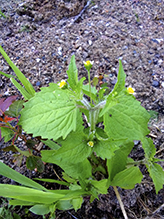 |
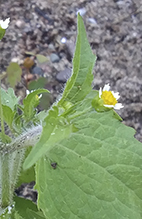 |
||||
MinnesotaSeasons.com Photos |
|||||
Plant |
|||||
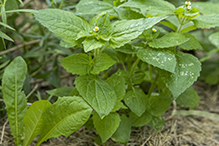 |
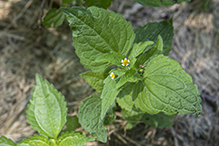 |
||||
Inflorescence |
|||||
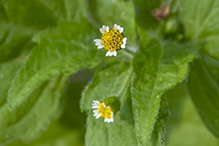 |
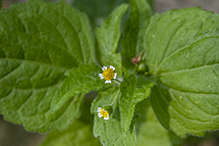 |
||||
Leaves |
|||||
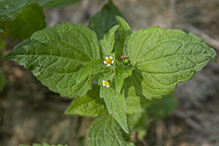 |
|||||

Slideshows |
||
| ASTERACEAE - Galinsoga quadriradiata Mauricio Mercadante |
||
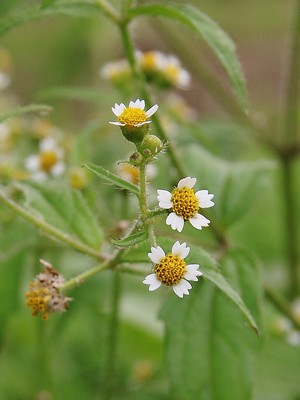 |
||
About
Galinsoga quadriradiata Ruiz & Pav. ASTERACEAE Local: Nova Petrópolis, RS, Brasil. Ref.: Moreira, H.J.C. e Bragança, H.B.N. Manual de Identificação de Plantas Infestantes: Culturas de Verão. Campinas, São Paulo, 2010. |
||

Visitor Videos |
|||
Share your video of this plant. |
|||
| This button not working for you? Simply email us at info@MinnesotaSeasons.com. Attach a video, a YouTube link, or a cloud storage link. |
|||
Other Videos |
|||
| Shaggy soldier (Galinsoga quadriradiata) - 2018-07-02 Westdelta |
|||
About
Jul 25, 2018 Galinsoga quadriradiata is a species of flowering plant in the daisy family which is known by several common names, including shaggy soldier,[2][3] Peruvian daisy, hairy galinsoga. Geo location: 52.050810, 4.418853 |
|||
| Weed, Galinsoga quariradiata,quickweed,Shaggy soldier,galinsoga weed indigenous and exotic flora |
|||
About
Mar 19, 2022 |
|||

Visitor Sightings |
|||||
Report a sighting of this plant. |
|||||
| This button not working for you? Simply email us at info@MinnesotaSeasons.com. Be sure to include a location. |
|||||
| Luciearl 8/22/2022 |
Location: Lake Shore These have been popping up on my beach. Wondering if it is non-native and I should pull. |
||||
MinnesotaSeasons.com Sightings |
|||||

Created: 9/13/2022
Last Updated:
